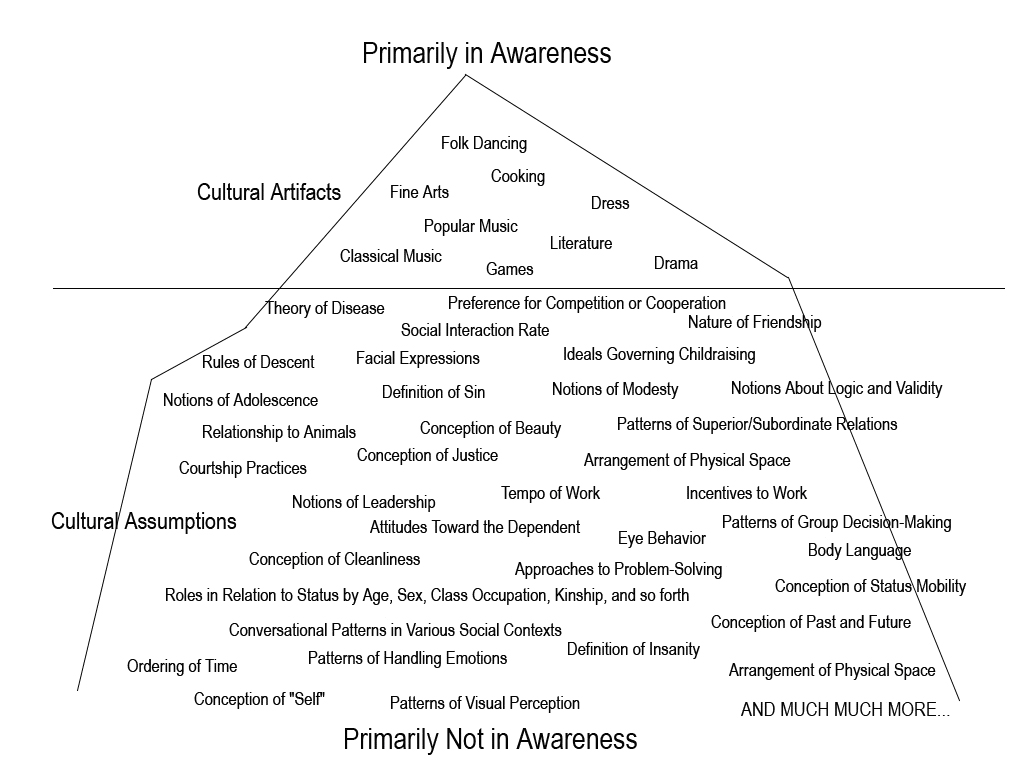

Class Activity & Portfolio Exercise 1: Intercultural communication case studies
Portfolio Exercise 2: Comparison of websites between different cultures
Portfolio Exercise 3: Differences in cultural interpretations: Mick Jagger in Iran
Week 7 Audio Lecture This is an older version of this lecture given by Ray as my attempt to record the Campbelltown lecture somehow didn't work.
Q: "Differences in culture are not merely a matter of differences in language." How is this statement reflected in the articles about intercultural communication?
Week 7 – Intercultural Communication
Culture is not some exotic notion studied by a select group of anthropologists in the South Seas. It is the mould in which we are all cast, and it controls our daily lives in many unsuspected ways. Edward T Hall (1959) The Silent Language
The concept of culture is a tricky one. Because for the most part it is invisible, we are often unaware of exactly how much of what think, perceive and do, is influenced by our enculturation – that is, our immersion in our culture. We are all born into a particular culture and we learn how to behave (customs and rituals), what is acceptable and not acceptable (norms) and how to view the world (worldview), through our culture. Many of our social institutions such as our parliament, laws and schools, reflect our cultural values. For this reason therefore, different cultural groups will view the world differently and deal with communication differently.
So let's start with a definition.
Culture is a learned, shared, compelling, interrelated set of symbols whose meanings provide a set of orientations for members of a society. These orientations, taken together, provide solutions to problems that all societies must solve if they are to remain viable.[1] Vern Terpstra and Kenneth David The Cultural Environment of International Business
As the quotes above illustrate, culture is a complex set of interrelationships and guidelines which impact on our perceptions. Theorists often use the analogy of a tree or an iceberg to visually portray the influence of our culture on our lives. These metaphors illustrate that there are certain things which are visible or 'primarily in awareness' with respect to the influence of culture, while there are an even greater number which lie below the surface. This image comes from: http://www.hrsa.gov/culturalcompetence/curriculumguide/AppendixA.htm
 |
The readings for this week explore different aspects of culture and the way it impacts on our lives. Can you think of examples from your own experiences? For an easy to read introduction to this topic, have a look at this site from an anthropology student resource titled "Human Culture".
 .
.
For a detailed overview of this topic, read Chapter 4 of your textbook
Two influential theories of cultural difference
While there is much written about culture, two important 20th century researchers deserve mention here as their theories have had a major influence on how we understand the impact of culture.
We mentioned Hall in our discussion of non verbal communication, as the anthropologist who coined the term 'proxemics': the study of how people use space. He has written a number of books about both non verbal communication and culture, including The Silent Language (1959 & 1990), The Hidden Dimension (1969) and Beyond Culture (1976). Hall argued that cultural differences could be better understood if they were divided into two groups: high context and low context. A key factor in his theory is context. This relates to the framework, background, and surrounding circumstances in which communication or an event takes place. Here's some more information.
The following summary highlights the problems facing low-context North Americans when they interact with people from high-context cultures.
a. High-context cultures (including much of the Middle East, Asia, Africa, and South America) are relational, collectivist, intuitive, and contemplative. This means that people in these cultures emphasize interpersonal relationships. Developing trust is an important first step to any business transaction. According to Hall, these cultures are collectivist, preferring group harmony and consensus to individual achievement. And people in these cultures are less governed by reason than by intuition or feelings. Words are not so important as context, which might include the speaker’s tone of voice, facial expression, gestures, posture—and even the person’s family history and status. A Japanese manager explained his culture’s communication style to an American: “We are a homogeneous people and don’t have to speak as much as you do here. When we say one word, we understand ten, but here you have to say ten to understand one.” High-context communication tends to be more indirect and more formal. Flowery language, humility, and elaborate apologies are typical.
b. Low-context cultures (including North America and much of Western Europe) are logical, linear, individualistic, and action-oriented. People from low-context cultures value logic, facts, and directness. Solving a problem means lining up the facts and evaluating one after another. Decisions are based on fact rather than intuition. Discussions end with actions. And communicators are expected to be straightforward, concise, and efficient in telling what action is expected. To be absolutely clear, they strive to use precise words and intend them to be taken literally. Explicit contracts conclude negotiations. This is very different from communicators in high-context cultures who depend less on language precision and legal documents. High-context business people may even distrust contracts and be offended by the lack of trust they suggest.
Dr. Geert Hofstede conducted perhaps the most comprehensive study of how values in the workplace are influenced by culture. From 1967 to 1973, while working at IBM as a psychologist, he collected and analyzed data from over 100,000 individuals from forty countries. From those results, and later additions, Hofstede developed a model that identified four primary dimensions with which to analyse and differentiate cultures. He later added a fifth dimension. These dimensions work on a continuum which measures the degree to which different cultures exhibit these characteristics. They are:
a. Power distance
b. Individualism-collectivims
c. Masculinity-femininity
d. Uncertainty Avoidance
e. LongtTerm-Short-term OrientationHofstede's research has been used widely in business as a training aid in understanding international cultural relationships. For more detail on the dimensions, check out Hofstede's site and his explanation of how the dimensions work.
To see how the orientation rankings are applied in the workplace, check out this link. For a critique of Hofstede's research, read this journal article.
There has been much debate
over the years about the extent to which language is a reflection of culture
and the extent to which culture impacts on language
use. A famous theory which examined this relationship is called the Sapir-Whorf
hypothesis. Click here for
some more detailed information about Sapir and Whorf. This  link will give
you a good overview of the relationship between language,
.
link will give
you a good overview of the relationship between language,
.
An interesting example of this is a fascinating book by UK author Adam Jacot de Boinod called "The Meaning of Tingo" in which he explores exotic words from other languages for which there is no direct translation in English. These words, he says, can tell you more about the culture than a vast majority of guidebooks. What does this say about the relationship between thought and language? Examples include:
NAKHUR, a six letter Persian word meaning a camel that won’t give milk until her nostrils are tickled.
GURFUR is a uniquely telling word. It’s an Arabic word and it means the amount of water scooped up with one hand.
And then of course Hawaiian is just a godsend because it’s got OHKULLANOCKANOCKA, meaning a day spent in nervous anticipation of a coughing spell.
 Here's a couple of newpaper
articles with some more examples on "The
Meaning of Tingo" and
its sequel, "More Tingo". Check out this YouTube video about the book.
Here's a couple of newpaper
articles with some more examples on "The
Meaning of Tingo" and
its sequel, "More Tingo". Check out this YouTube video about the book.
For a further example, several years ago, Australian cricketer Matthew Hayden was in trouble for calling Indian cricketer Harbhajan Singh "an obnoxious little weed". The problem was that while the Indian press were livid, they had trouble explaining to their readers what the insult meant. See the Sydney Morning Herald report. Are you aware of any words or expressions which might be an example of this? What might this say about the relationship between language and culture?
Non
verbal communication

As we discussed in week 4, there is a significant relationship between non verbal communication and culture. Things like greeting gestures, perceptions of time and use of space, dress, facial expressions and so on, are hugely influenced by our cultural backgrounds. For more detailed information about these, try these links.
This site looks at gestures and
has some interesting questions to test your perceptions while this site looks
at a range
of different non verbal cues and how they might be interpreted
differently in different cultures. For more detail here's a university
paper on the relationship between culture and non verbal communication
.
Finally, in December 2008, US President George W. Bush was pelted with shoes while giving a press conference in Baghdad. This is an insult in the Arab world. See the YouTube video . This was reenacted during the 2011 protests in Egypt when protesters held up their shoes in disdain at the long serving government as can be seen in this picture from the uprising.
Class Activity & Portfolio Exercise 1: Intercultural communication case studies
Read Case study 4.3 on p.101 of your textbook. Write a brief (150 words each) commentary on at least three (3) of them, discussing the possible causes of intercultural conflict or miscommunication.
Portfolio Exercise 2: Comparison of websites between cultures
Choose an international well-known product brand such as Coca Cola, KFC or a product such as jeans or joggers. Use Google, to do a search for at least 3 other websites from different countries for the same product or company eg American, Australian, Chinese and/or Japanese. Write about 500 words and include a screen shot of the web pages you are discussing.
NOTE – For some
help on how to do this well, you might read the following journal article
by Wurtz
(2005) titled "A cross-cultural analysis of websites from
high-context cultures and low-context cultures".
Portfolio Exercise 3: Differences in cultural interpretations: Mick Jagger in Iran
Read this brief newspaper clipping on the reaction to a portrait of Rolling Stones singer Mick Jagger in Iran. How is the Iranian reaction to the painting a reflection of different worldviews? Write about 300 words. [Hint: you might want to do a Google search on the term 'worldview' and relate it to what the article is about].
Other useful links on cross cultural communication
For more detail have look at this website on cross cultural awareness which includes a good video. Try exploring the other links.
Try this journal article titled "Transcending Cultural Barriers: Context, Relationships, and Time".
Our textbook has been newly revised especially for this unit. Most lectures and many class activities will be based on the book, so we recommend that all students have access to a copy and bring it to class every week. Copies will be made available in the Library Closed Reserve.
In addition, class discussions and presentations will be based on more specific readings on the weekly topic. These can be found under the 'Tutorial Readings' tab at the top of this page.